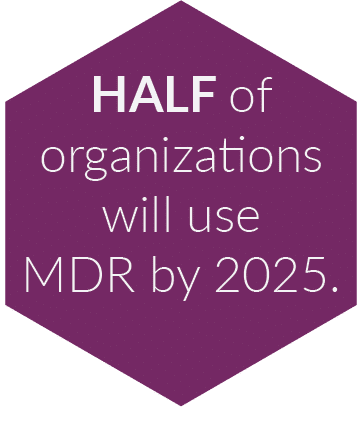Managed Threat Detection & Response: Prevent Cyberattacks

With 70% of breaches today originating at endpoints—such as servers, laptops, Internet of Things (IoT), and mobile devices—it’s increasingly important for organizations to implement a robust security strategy like managed threat detection and response to protect against threats. But navigating the threat detection and response solutions landscape can be confusing, especially for businesses that lack deep cybersecurity expertise.
This article describes two popular approaches to threat detection and response and helps you choose the right one for your business.
What Is Managed Threat Detection and Response?
Managed detection and response (MDR) is an outsourced cybersecurity solution offered by a managed security service
comprehensive array of network, host, and endpoint security tools that perform ongoing monitoring to identify and respond to threats pre-emptively. MSSPs also provide specialized cybersecurity expertise.
What Is MDR vs. EDR?
Unlike MDR, which is a service, endpoint detection and response (EDR) is a cybersecurity platform that helps organizations identify and respond to threats that target vulnerable, network-connected endpoints. The biggest difference between EDR and MDR is scale.
| Benefits | Best for organizations that… | May not be ideal for organizations that… | |
| EDR |
|
|
|
| MDR |
|
|
|
Managed Detection and Response Addresses Common Security Threats
To manage threats effectively, organizations first need to know what kinds of threats MDR can help mitigate. This list covers the most common types.
Ransomware
Ransomware is malware that attacks a computer, network, or server. Malicious software locks the victim’s device, then a cybercriminal demands payment to restore it.
Phishing
Phishing attacks target individuals using social engineering methods, such as email, phone, texting, and social media. They aim to manipulate the recipient into revealing sensitive information like their password or credit card number. Some phishing attacks install viruses on the victim’s device.
Denial of Service
Denial-of-Service (DoS) attacks target organizations with the goal of disrupting business operations by inundating a network or server with spam requests. When the target becomes overwhelmed, necessary business services become unavailable, so employees can no longer perform their tasks. Although DoS attacks rarely exploit ransomware, the disruption they cause can be costly.
A Distributed Denial-of-Service (DDoS) attack is a more serious type of DoS attack. Here, multiple machines overload an edge network device—such as a router or switch—rather than targeting a server.
Man in the Middle
Man in the Middle (MitM) refers to a category of identity-based cyberattacks in which a bad actor surreptitiously eavesdrops on an online communication between a client and a server. The most common MitM attack exploits vulnerabilities in the victim’s browser to inject malware into their device. Cybercriminals commonly use MitM attacks to capture sensitive financial data in real time by intercepting traffic between a user and a banking website.
Other cybersecurity threats
Today’s cybersecurity environment includes many other dangers, including blended threats that leverage multiple methods and previously unseen zero-day threats.
As the IT perimeter continues to blur, organizations need to stay ahead of threats, such as
- Sophisticated mutating software
- Advanced persistent threats (APTs) that gather intelligence through surveillance
- Cloud vulnerabilities
- Web application attacks, such as a SQL injection (SQLI)
- Supply chain attacks that target trusted relationships and third parties
- Spoofing attacks disguised as legitimate websites and email addresses
How to Get the Protection You Need
OneNeck partnered with Fortra’s Alert Logic to bring together a powerful set of capabilities that ensure businesses get all the security protection they need:
- The Platform—Provides comprehensive security coverage, regardless of whether your workloads are in one or many clouds, containers, serverless, or on premises
- The Intelligence—Includes dozens of seasoned security researchers, data scientists, and engineers with vast industry experience
- The Expertise—Fortra’s 150 skilled security operations center (SOC) analysts partner with OneNeck’s security experts, who act as your point of contact. As your managed services provider, we understand your IT environment and are committed to keeping it safe.
Let Fortra’s Alert Logic and OneNeck Protect Your Network
No organization is too small to experience a breach. Make sure you don’t become a victim.
Do you need a better security strategy for the cloud or expert security talent to help protect your IT infrastructure? Or maybe you just want to reduce your total cost of ownership (TCO)?
Together, One Neck and Fortra’s Alert Logic can help you implement a managed threat detection and response strategy that provides comprehensive security in today’s risky IT landscape.
Contact us to learn how you can protect against threats in real time.
Frequently asked questions…
Does MDR replace SIEM?
Managed Detection and Response (MDR) and Security Information and Event Management (SIEM) are both security solutions, but they serve different purposes and are not direct replacements for each other. SIEM is primarily focused on log management, correlation, and event analysis to provide a comprehensive view of security threats, while MDR is a more proactive solution that combines threat intelligence, behavior analytics, and expert analysis to detect and respond to advanced threats.
What’s the difference between MSP and MSSP?
Managed Service Providers (MSPs) and Managed Security Service Providers (MSSPs) both provide managed services to clients, but their focus areas differ. MSPs primarily provide managed services for IT infrastructure and operations, while MSSPs specialize in managed security services, such as threat detection, incident response, and compliance management. MSSPs typically offer a broader range of security-focused services and have more specialized expertise than MSPs.
Is EDR the same as antivirus?
Endpoint Detection and Response (EDR) and antivirus (AV) software are both security solutions that protect against malware and other threats, but they have different approaches and capabilities. AV software uses signature-based detection to identify known threats and prevent them from infecting the system, while EDR is a more advanced solution that uses behavior-based analysis and machine learning to detect and respond to both known and unknown threats.
What is endpoint security?
Endpoint security refers to the practice of securing endpoints, such as desktops, laptops, smartphones, servers, and other network-connected devices, from cyber threats. The goal of endpoint security is to protect these endpoints from unauthorized access, data theft, malware, and other types of cyberattacks by using a combination of technologies, tools, and policies to detect, prevent, and respond to threats.
Additional Resources:




